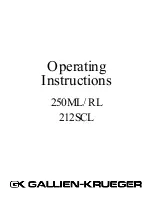
Reference Manual
Rio Rancho, NM
DMPA12 Programmable I/O Commands
Command Description
prgin
Programmable input state
prgindef
Programmable input definition
prginundef
Programmable input un-definition
prgout
Programmable output state
prgoutdef
Programmable output definition
prgoutiv
Programmable output invert
Termination: all commands are terminated with an
ASCII carriage return character (hex code 0x0D), rep-
resented by <CR> in the examples below. All responses
are terminated with an ASCII carriage return, line feed
pair (hex codes 0x0D, 0x0A), represented by <CRLF>
in the examples below. An ellipsis (...) represents
members of an array that have been omitted from an
example for the sake of brevity.
Verbose response: commands prefixed with an ex-
clamation point (bang) character result in a “verbose”
response containing the name of the property or ac-
tion being addressed, along with the current values of
the property in question. Property values are always
returned in the “assignment” form, for example out-
mt(2)=1. This supports certain 3rd party control pro-
gramming styles where the response to all responses
needs to be self-describing and/or contain current
property values.
Examples:
REQUEST
RESPONSE
COMMAND !store(3)<CR>
OK store(3)<CRLF>
COMMAND !run={1,3,5}<CR>
OK run={1,3,5}<CRLF>
QUERY
!outgn(3)?<CR>
OK outgn(3)=0<CRLF>
QUERY
!outmt(*)?<CR>
OK outmt(*)={0,1,1,...,0,0,0}
<CRLF>
UPDATE
!outgn(3)=0<CR>
OK outgn(3)=0<CRLF>
UPDATE
!outmt(*)={0,1,1,...,
0,0,0}<CR>
OK outmt(*)={0,1,1,...,0,0,0}
<CRLF>
prgin (programmable input state)
This command may be used to simulate a momentary
contact closure on a programmable input or as a query
to read the state of programmable inputs. The program-
mable input is specified by using the address syntax.
Addresses must be in the range 1 to 11. Note: simu-
lated contact closures have no effect for programmable
inputs configured for analog gain control. The data type
returned by queries is integer, with the possible values
depending on the nature of the function assigned to the
programmable input.
For analog gain control functions the values are the
range 0 to 255, representing the voltage sensed by the
programmable input (0 is 0 volts, 255 is 5 volts). For
all other functions the value is either “1” meaning that
the input is active (closed), or “0” meaning that it is not
(open). The channel address may be wildcarded in que-
ries, in which case the data type is an array of integer of
size 11.
Examples:
REQUEST
RESPONSE
COMMAND prgin(11)<CR>
OK<CRLF>
QUERY
prgin(9)?<CR>
OK 1<CRLF>
QUERY
prgin(*)?<CR>
OK {0,0,1,...,0,0,0}<CRLF>
prgindef (programmable input definition)
This command may be used as a query to read a pro-
grammable input definition, or as an update to modify
the definition. The programmable input is specified by
using the address syntax. Addresses must be in the
range 1 to 11. The data type is array of integer, with a
variable length. The values contained in the array rep-
resent the definition of a programmable input, using the
following scheme:
• The
first integer
is a code that specifies the func-
tion that is assigned to the programmable input. It
may be in the range 0 to 8, with the following mean-
ings:
Code
Function
0
No function assigned
1
Analog output gain control
2
Increment output gain 1 dB
3
Decrement output gain 1 dB
4
Recall preset from memory
5
Toggle mute on output
6
Momentary mute on output
7
Run a macro on close
8
Run macros on close/open
The choice of function determines what happens
when the programmable input is asserted. The
choice of function affects the interpretation of the
subsequent values in the array, which identify the
target of the function.
NOTE: All gain changes made by programmable
input functions affect rear panel gain only.
Содержание DMPA12
Страница 2: ...DMPA12 Digital Power Amplifier LECTROSONICS INC ...
Страница 55: ...Reference Manual Rio Rancho NM 55 ...












































